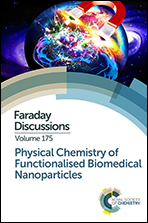Controlling Droplet Cell Environment in Scanning Electrochemical Cell Microscopy (SECCM) via Migration and Electroosmotic Flow
IF 3.3
3区 化学
Q2 CHEMISTRY, PHYSICAL
引用次数: 0
Abstract
Scanning electrochemical cell microscopy (SECCM) is a powerful nanoscale electrochemical technique that advances our understanding of heterogeneity at the electrode-electrolyte interface. Dual-channel nanopipettes can often serve as the probe, and a voltage bias between the channels can control the local electrolyte environment via migration and electroosmotic flow (EOF). The ability to elucidate and predict the contribution of each transport is desirable. In this work, we measured the limiting current of different redox molecules to experimentally elucidate the contribution of migration and EOF at the droplet-substrate interface in SECCM. The results were further supported by fluorescence imaging and finite element modeling. We showed that redox mediators with high charge, such as Ru(NH3)63+, migration contributes 5× as much mass transport limiting current compared to EOF when a bias voltage is applied. The exact contribution of each mode at a given potential bias depends on the electrical double layer structure, which can be tuned by the surface charge and solution composition. The contribution can be quantitatively predicted in the finite element model. Our findings will enable the precise control of mass transport in dual-channel SECCM and potentially open new scanning modes in SECCM via precise control of reaction flux.通过迁移和电渗流控制扫描电化学样品池显微镜 (SECCM) 中的液滴池环境
扫描电化学细胞显微镜(SECCM)是一种功能强大的纳米级电化学技术,可加深我们对电极-电解质界面异质性的了解。双通道纳米移液管通常可作为探针,通道之间的电压偏置可通过迁移和电渗流(EOF)控制局部电解质环境。我们希望能够阐明和预测每种传输的贡献。在这项工作中,我们测量了不同氧化还原分子的极限电流,通过实验阐明了 SECCM 中液滴-基底界面上迁移和 EOF 的贡献。荧光成像和有限元建模进一步支持了这一结果。我们的研究表明,当施加偏置电压时,Ru(NH3)63+ 等高电荷氧化还原介质的迁移对质量传输限制电流的贡献是 EOF 的 5 倍。在给定的电位偏置下,每种模式的确切贡献取决于电双层结构,而电双层结构可通过表面电荷和溶液成分进行调整。这种贡献可以在有限元模型中进行定量预测。我们的研究结果将有助于精确控制双通道 SECCM 中的质量传输,并有可能通过精确控制反应通量在 SECCM 中开辟新的扫描模式。
本文章由计算机程序翻译,如有差异,请以英文原文为准。
求助全文
约1分钟内获得全文
求助全文
来源期刊

Faraday Discussions
化学-物理化学
自引率
0.00%
发文量
259
期刊介绍:
Discussion summary and research papers from discussion meetings that focus on rapidly developing areas of physical chemistry and its interfaces
 求助内容:
求助内容: 应助结果提醒方式:
应助结果提醒方式:


